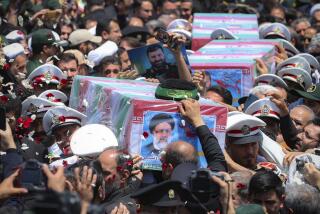Friday Prayers a Colorful Iran Institution : Cleric-Led Regime Uses Meetings to Rally Support for Policies
- Share via
TEHRAN — Mass Friday prayers in Tehran have become a colorful institution for the people who forged Iran’s 1979 revolution and a key channel to convey the Islamic vision of their spiritual leader, the Ayatollah Ruhollah Khomeini.
The meetings, often attended by hundreds of thousands of people, are echoed throughout Iran as a result of Khomeini’s edict that “Friday prayers are the most glorious fruit of the revolution.”
Iran’s clerical government uses Friday prayers to rally support for its policies. Millions turned out earlier this year to back a “war to victory” call against Iraq.
Every Friday, worshipers start arriving at Tehran University soon after dawn to find good places in the men-only scaffold and tarpaulin prayer hall on the university’s old soccer field. Women, in black or off-white enveloping chadors, take a different entrance and sit behind a screen stretched between trees.
Some worshipers spill onto streets adjoining the campus, lining up in rows along white, diagonally painted lines so they can face the holy Muslim city of Mecca, in Saudi Arabia.
Government dignitaries sit in a section at the front, while nearby 100 Iraqi prisoners of war are lined up to pray with some Iranian soldiers and war wounded.
For worshipers not in the main area, loudspeakers and a live radio broadcast relay sermons by prominent revolutionaries on official religious and political issues of the day.
Khomeini’s Secretariat names prayer leaders for all Iranian cities, and they, with his representatives appointed to Islamic organizations, government bodies and Shia Muslim communities abroad, are a key channel to put over his Islamic vision.
Recent speakers in Tehran included Prime Minister Hossein Mousavi, who defended his government’s record, and the politically powerful Majlis (Parliamentary) Speaker, Hashemi Rafsanjani, a cleric who was also prayer leader.
As he spoke, Rafsanjani casually handled the barrel of a semi-automatic rifle just visible over the lectern. Prayer leaders in Iran follow an ancient Islamic practice in carrying arms when they conduct their meetings.
The popularity of Rafsanjani’s authoritative, conversational oratory was shown by worshipers who gave him a two-minute, slogan-shouting ovation on arrival.
Slogans are a central theme of Tehran’s Friday prayers, many of them rolling with an easy familiarity from worshipers rhythmically punching the air with their right arms.
A master of ceremonies leads them through new slogans from a rostrum bedecked with banners condemning the United States and Iraq and praising Islam. Sweeping his arm up for effect, the teacher warms the crowd with a religious theme of the week. A favorite is when women chant the first half of a slogan and men reply with shouts.
The session ends with the slogan: “God is great, Khomeini is the leader, death to America, death to the Soviets, death to the hypocrites and Saddam (Hussein, Iraq’s president), death to Israel” and then an oath of allegiance to Khomeini.
More to Read
Sign up for Essential California
The most important California stories and recommendations in your inbox every morning.
You may occasionally receive promotional content from the Los Angeles Times.












